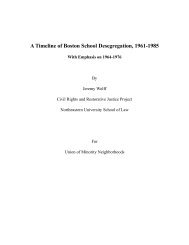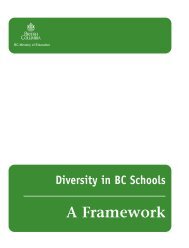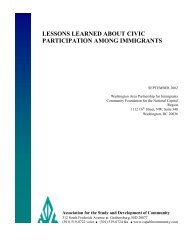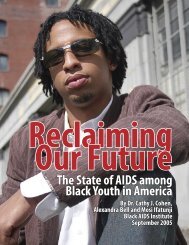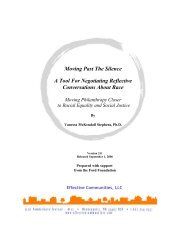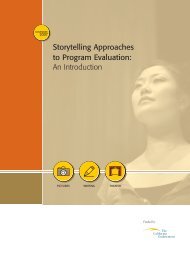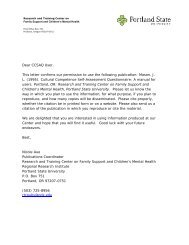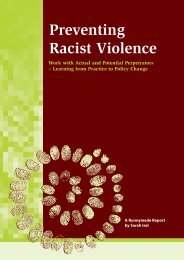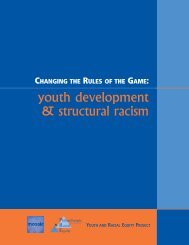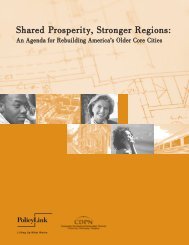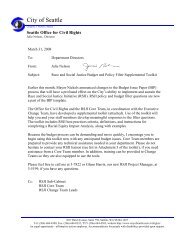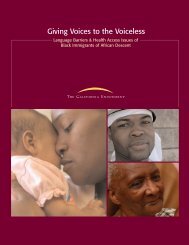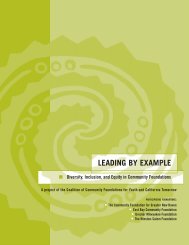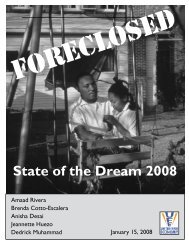EQUITABLE PUBLIC INVESTMENTI. F. CONFRONTING RACIALINEQUALITY AND LANDREFORM: DETROIT BRANCHNAACP & MICHIGAN LANDUSE INSTITUTE PARTNERSHIPFunders Highlighted:Ford FoundationW.K. Kellogg FoundationMichigan L<strong>and</strong> Use Funders Group“A few years ago, one could not have imag<strong>in</strong>edDetroiters <strong>and</strong> suburbanites talk<strong>in</strong>g about theircommon concerns with loss <strong>of</strong> tax base <strong>and</strong>decl<strong>in</strong><strong>in</strong>g <strong>in</strong>frastructure. What a change!”— Karen Aldridge-Eason, Office <strong>of</strong> theGovernorThe belief that current l<strong>and</strong> use trends <strong>and</strong> patterns areendanger<strong>in</strong>g the state <strong>of</strong> Michigan <strong>and</strong> the quality <strong>of</strong> life<strong>of</strong> all <strong>of</strong> its residents is a shared concern among agrow<strong>in</strong>g number <strong>of</strong> both community leaders <strong>and</strong> state<strong>of</strong>ficials. As a result, an <strong>in</strong>formal coalition—referred toas the Michigan L<strong>and</strong> Use Funders Group, <strong>in</strong>clud<strong>in</strong>gprivate foundations, community foundations, <strong>and</strong> a keystate agency—formed several years ago to supportprojects that address matters <strong>of</strong> preservation <strong>and</strong>revitalization. This pr<strong>of</strong>ile br<strong>in</strong>gs to light the social <strong>and</strong>political strides made <strong>in</strong> Michigan by funders <strong>and</strong>organizers work<strong>in</strong>g towards l<strong>and</strong> reform. By br<strong>in</strong>g<strong>in</strong>gtogether communities across different racial <strong>and</strong>socioeconomic l<strong>in</strong>es to build a common language <strong>and</strong>strive towards a common goal <strong>of</strong> l<strong>and</strong> reform, funders,organizers, <strong>and</strong> participants are also challeng<strong>in</strong>g historicpatterns <strong>of</strong> segregation <strong>and</strong> disempowerment.Project Pr<strong>of</strong>ileAn <strong>in</strong>formal coalition known as the Michigan L<strong>and</strong> UseFunders Group has been work<strong>in</strong>g together s<strong>in</strong>ce 1994<strong>and</strong> currently <strong>in</strong>cludes over 20 funders. 15 Oneparticipant, the W.K. Kellogg Foundation, has createdLiv<strong>in</strong>g for the City, a project funded by the Foundation’sPeople <strong>and</strong> L<strong>and</strong> (PAL) Program, a historic first-steptowards engag<strong>in</strong>g communities <strong>of</strong> color <strong>and</strong> broadurban perspectives <strong>in</strong> Michigan’s l<strong>and</strong> use reform.Moreover, this <strong>in</strong>novative <strong>in</strong>itiative brought together thepredom<strong>in</strong>antly African American Detroit BranchNAACP, the nation’s largest chapter <strong>of</strong> the national civilrights organization, <strong>and</strong> the predom<strong>in</strong>antly white <strong>and</strong>northern Michigan organization, the Michigan L<strong>and</strong>Use Institute (MLUI), to pursue common goals <strong>of</strong> l<strong>and</strong>reform, dialogue creation, <strong>and</strong> <strong>in</strong>formation shar<strong>in</strong>g.Focus<strong>in</strong>g on three issues crucial to urbanrevitalization—affordable hous<strong>in</strong>g, public transit,<strong>and</strong> race relations—a series <strong>of</strong> communitystakeholder meet<strong>in</strong>gs, presentations, <strong>and</strong> discussionselevate <strong>and</strong> promote the relevance <strong>of</strong> l<strong>and</strong> use reformfor the urban experience. These dialogues aim toadvance three goals to foster:• Citizen education that helps residents to draw theconnection between the adoption <strong>of</strong> a l<strong>and</strong> usevision <strong>and</strong> positive changes <strong>in</strong> their own lives;• <strong>Leadership</strong> development that aids legislators <strong>and</strong>local leaders <strong>in</strong> learn<strong>in</strong>g more about l<strong>and</strong> usepolicy; <strong>and</strong>• Informed change that identifies <strong>and</strong> supportslocal experts to advance best practices <strong>and</strong>provide ongo<strong>in</strong>g assistance <strong>in</strong> this still unfold<strong>in</strong>gpublic dialogue.Access to public transportation is an important element <strong>of</strong> a regional <strong>and</strong>neighborhood equity framework <strong>in</strong> Detroit, as <strong>in</strong> many other communities.(Source: Michigan L<strong>and</strong> Use Institute).Through the sum <strong>of</strong> these efforts, the issues <strong>and</strong>concerns specifically identified by Detroit residents15Coord<strong>in</strong>ated by the Council <strong>of</strong> Michigan Foundations, participants <strong>in</strong>the Michigan L<strong>and</strong> Use Funders Group <strong>in</strong>clude: Americana Foundation,Beldon Fund, Carls Foundation, Charlevoix County CommunityFoundation, Community Foundation for Muskegon County,Community Foundation for Southeastern Michigan, CommunityFoundation <strong>of</strong> Monroe County, Fremont Area Community Foundation,Frey Foundation, Hudson-Webber Foundation, W.K. KelloggFoundation, Keweenaw Community Foundation, Kresge Foundation,Michigan Department <strong>of</strong> Environmental Quality—Coastal ManagementProgram, McGregor Fund, Charles Stewart Mott Foundation, Petoskey-Harbor Spr<strong>in</strong>gs Area Community Foundation, Rotary Charities <strong>of</strong>Traverse City, <strong>and</strong> Wege Foundation.41Funders’ Network for Smart Growth <strong>and</strong> Livable Communities
<strong>and</strong> bus<strong>in</strong>esses are quantified <strong>in</strong> a spr<strong>in</strong>g 2005report titled, Liv<strong>in</strong>g for the City—Smart Growth <strong>in</strong>Detroit. The report’s recommendations are <strong>in</strong>tendedto serve as a guide to further advance urban l<strong>and</strong>use reforms <strong>in</strong> the state’s largest city <strong>and</strong>metropolitan region.Funder InterestIn early 2003, the bipartisan appo<strong>in</strong>tments byMichigan’s newly-elected governor <strong>and</strong> top legislativeleaders led to the appo<strong>in</strong>tment <strong>of</strong> an esteemed <strong>and</strong><strong>in</strong>dependent group <strong>of</strong> 26 advisors known as theMichigan L<strong>and</strong> Use <strong>Leadership</strong> Council. Theircharge was to <strong>of</strong>fer a report to state government onhow best to protect <strong>and</strong> preserve Michigan’s l<strong>and</strong>,communities, <strong>and</strong> economic vitality. Staff support forthe <strong>Leadership</strong> Council was provided by participants<strong>in</strong> the Michigan L<strong>and</strong> Use Funders Group (which is<strong>in</strong> turn coord<strong>in</strong>ated by the Council <strong>of</strong> MichiganFoundations). As a result, over six months <strong>in</strong> 2003,the <strong>in</strong>tense <strong>and</strong> exhaustive deliberations <strong>of</strong> theCouncil drew upon both expert presentations <strong>and</strong>public comments. Still, <strong>in</strong> spite <strong>of</strong> the devotion <strong>of</strong> anentire chapter <strong>of</strong> the Council’s report to urbanrevitalization, the absence <strong>of</strong> urban <strong>and</strong> m<strong>in</strong>orityvoices was all too obvious.The Council’s lack <strong>of</strong> urban <strong>and</strong> m<strong>in</strong>ority participationmirrors Michigan’s segregation patterns. As documentedby the U.S. Census Bureau, five <strong>of</strong> the country’s mostracially segregated metropolitan regions are Michigancities: Detroit, Sag<strong>in</strong>aw, Fl<strong>in</strong>t, Benton Harbor, <strong>and</strong>Muskegon. One <strong>of</strong> every seven residents <strong>in</strong> Michigan isAfrican American; yet <strong>in</strong> Detroit, eight <strong>of</strong> every tenresidents are African American. Furthermore, 96 percent<strong>of</strong> Michigan’s black residents live <strong>in</strong> just 11 metropolitanregions. Hence, 70 <strong>of</strong> the state’s 83 counties areoverwhelm<strong>in</strong>gly white, with m<strong>in</strong>ority populations <strong>of</strong> lessthan 3 percent.It is aga<strong>in</strong>st the backdrop <strong>of</strong> this disparity <strong>in</strong>representation <strong>and</strong> exclusion from decisionmak<strong>in</strong>gthat Bill Rustem, president <strong>and</strong> CEO <strong>of</strong> the Lans<strong>in</strong>gbasedPublic Sector Consultants <strong>and</strong> PAL’s programadm<strong>in</strong>istrator declares, “We have to f<strong>in</strong>d ways tobridge the gaps. The same issues exist for farms <strong>and</strong>cities. Ultimately, the goals must also be the same.”L<strong>in</strong>da W. Helstowski, consultant to the Council <strong>of</strong>Michigan Foundations, agrees, add<strong>in</strong>g that theproject’s goals were “at the heart <strong>of</strong> address<strong>in</strong>g theneed to br<strong>in</strong>g different <strong>in</strong>terests together. We have toget <strong>in</strong>formation about problems <strong>and</strong> solutions topolicy reformers. So when we get a diverse set <strong>of</strong>people <strong>and</strong> leaders around the table—particularlyurban voices—we can work to <strong>in</strong>crease the skills <strong>and</strong>capacities <strong>of</strong> groups to be engaged.”<strong>Regional</strong>/Neighborhood Equity Impacts“People <strong>of</strong> color <strong>and</strong> urban dwellers are becom<strong>in</strong>gmore engaged <strong>in</strong> these issues <strong>and</strong> are ga<strong>in</strong><strong>in</strong>gmomentum throughprojects like theMLUI/DetroitNAACP <strong>in</strong>itiative,”observes KarenAldridge-Eason, aCharles Stewart MottFoundation programdirector on loan tothe state <strong>of</strong> Michiganas FoundationLiaison to the Office<strong>of</strong> the Governor.The Ford Foundation— L<strong>in</strong>da Helstowskigot <strong>in</strong>volved <strong>in</strong>support<strong>in</strong>g thepartnership for precisely this reason. The Foundationwas <strong>in</strong>terested <strong>in</strong> support<strong>in</strong>g a non-traditionalcollaboration between an African American organizationlike the NAACP <strong>and</strong> a traditionally whiteenvironmental organization like MLUI, <strong>in</strong> order bridgedialogues about social justice <strong>and</strong> smarter growth.Results“We have to get <strong>in</strong>formationabout problems <strong>and</strong>solutions to policy reformers.So when we get a diverseset <strong>of</strong> people <strong>and</strong> leadersaround the table—particularlyurban voices—we can work to<strong>in</strong>crease the skills <strong>and</strong>capacities <strong>of</strong> groups to beengaged.”Accord<strong>in</strong>g to Helstowski, this effort has “seeded thegroundwork” for additional untraditional alliances. “Iwas enthused to learn <strong>of</strong> the project. This learn<strong>in</strong>geffort can lay the groundwork for work<strong>in</strong>g together <strong>in</strong>different ways,” she adds. Helstowski cont<strong>in</strong>ues, “Thisproject is just one example <strong>of</strong> the array <strong>of</strong> effortssupported by foundations <strong>in</strong>volved <strong>in</strong> the MichiganL<strong>and</strong> Use Funders Group aimed at promot<strong>in</strong>g urbanre<strong>in</strong>vestment <strong>and</strong> l<strong>and</strong> preservation <strong>and</strong> engag<strong>in</strong>g amore diverse set <strong>of</strong> <strong>in</strong>formed voices <strong>in</strong> state policyreform. The funders meet regularly to share reflections<strong>and</strong> updates on projects underway across the state,lessons learned, <strong>and</strong> strategies <strong>and</strong> opportunities formov<strong>in</strong>g this important work forward.”EQUITABLE PUBLIC INVESTMENTPart III: Section 1: Promot<strong>in</strong>g Equitable Public Investment 42
- Page 1 and 2: Stories of Philanthropic Leadership
- Page 3 and 4: Signs of Promise:Stories of Philant
- Page 5 and 6: Funders’ Network for Smart Growth
- Page 7 and 8: (II. B.)(II. C.)Turning Neighborhoo
- Page 9 and 10: PART I:IntroductionThe Purpose of t
- Page 11 and 12: social justice issues as they relat
- Page 13 and 14: PART II:Perspectives on Advancing R
- Page 15 and 16: peer work, we can reestablish a sig
- Page 17 and 18: Annie E. Casey FoundationBaltimore,
- Page 19 and 20: neighborhoods into healthy ones—g
- Page 21 and 22: Charles and Helen Schwab Foundation
- Page 23 and 24: Section 1:Promoting Equitable Publi
- Page 25 and 26: I. A. BUILDING POWER AND GIVINGVOIC
- Page 27 and 28: policy advocates. In 2002, Milwauke
- Page 29 and 30: in Los Angeles, Ford’s Anthony no
- Page 31 and 32: I. B. PROMOTING COALITIONSTO ADVANC
- Page 33 and 34: Yet the interpersonal dynamics of c
- Page 35 and 36: guidelines. “Many of the member o
- Page 37 and 38: Funder InterestThe EPA supported th
- Page 39 and 40: I. D. DEMONSTRATING THESTRUGGLE FOR
- Page 41 and 42: Richmond, Calif.The second regional
- Page 43 and 44: through policy reform at the local
- Page 45 and 46: I. E. BUILDING COALITIONTHROUGH KNO
- Page 47: organizing project, the Connecticut
- Page 51 and 52: I. G. REVITALIZING WHILEASSURING DI
- Page 53 and 54: In the late 1990s, the city of Albu
- Page 55 and 56: I. H. A TRAVEZ DE LA FRONTERA:LAND
- Page 57 and 58: The International Community Foundat
- Page 59 and 60: I. I. MOBILIZING ACTION FORREGIONAL
- Page 61 and 62: To meet all of these objectives, th
- Page 63 and 64: efforts. And with each public plann
- Page 65 and 66: pattern of disproportionate transpo
- Page 67 and 68: Clinica de la Raza identify this cr
- Page 69 and 70: Contact PeopleCarl AnthonyActing Di
- Page 71 and 72: Section 2:Making All Neighborhoods
- Page 73 and 74: II. A. REACHING BEYONDHOUSING TO IM
- Page 75 and 76: A local resident receives the keys
- Page 77 and 78: East Baltimore community and the Jo
- Page 79 and 80: example, adjacent to the EBDI area,
- Page 81 and 82: II. C. YIELDING REGIONALBENEFITS TH
- Page 83 and 84: is using transit-oriented developme
- Page 85 and 86: financing and innovative, forward-t
- Page 87 and 88: The Row House Community Development
- Page 89 and 90: II. E. COUNTERING THE PERFECTSTORM:
- Page 91 and 92: funded community programs, includin
- Page 93 and 94: housing developments and commercial
- Page 95 and 96: owned enterprises, totaling $8.5 mi
- Page 97 and 98: LOAN GUARANTEESSection 3:Connecting
- Page 99 and 100:
III. A. MAKING HOUSING ANOPPORTUNIT
- Page 101 and 102:
A new report from the National Hous
- Page 103 and 104:
The Straphangers Campaign was found
- Page 105 and 106:
Funder InterestThe Straphangers Cam
- Page 107 and 108:
or increase poverty. Whether direct
- Page 109 and 110:
The Regional Plan Association then
- Page 111 and 112:
multi-stakeholder effort composed o
- Page 113 and 114:
director with LISC. No one set of s
- Page 115 and 116:
12 western Louisville neighborhoods
- Page 117 and 118:
III. E. UNITING THREE STATESFOR ONE
- Page 119 and 120:
increased their personal wealth by
- Page 121 and 122:
summary evaluation of MSDI found th
- Page 123 and 124:
method alone was strong enough to m
- Page 125 and 126:
consistent body of work. The Counci
- Page 127 and 128:
3) Issues Need to be ConnectedThe f
- Page 129 and 130:
PART V:Glossary of TermsThe terms d
- Page 131 and 132:
Regional and neighborhood equity. A
- Page 133 and 134:
Tijuana River Reserve, California:h
- Page 135 and 136:
Sargent Shriver National Center on
- Page 137:
1500 San Remo Avenue • Suite 249



